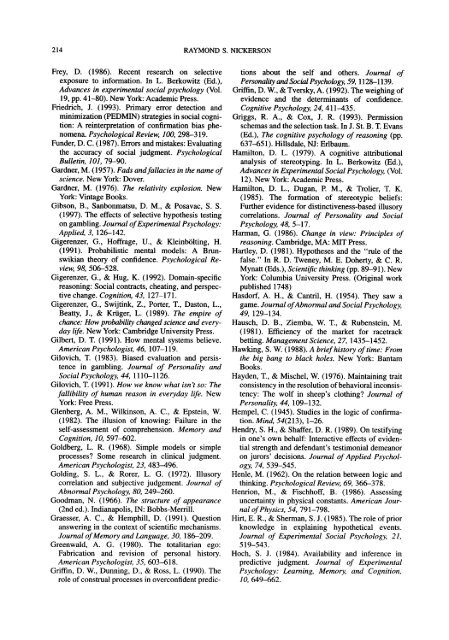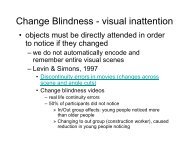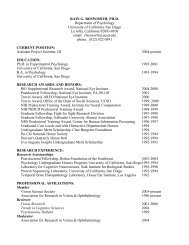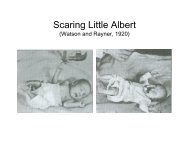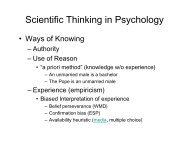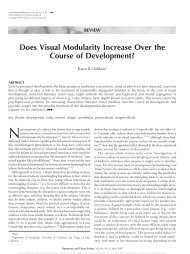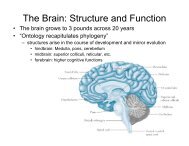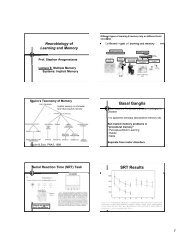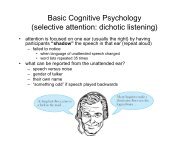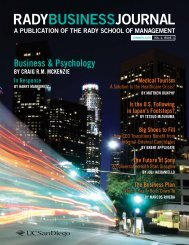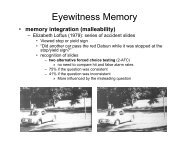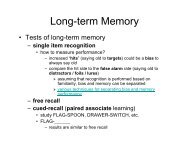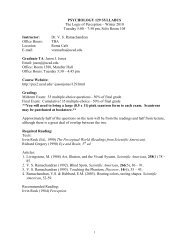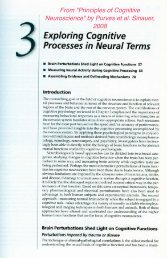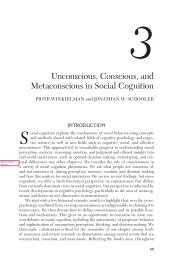Confirmation Bias: A Ubiquitous Phenomenon in Many Guises
Confirmation Bias: A Ubiquitous Phenomenon in Many Guises
Confirmation Bias: A Ubiquitous Phenomenon in Many Guises
You also want an ePaper? Increase the reach of your titles
YUMPU automatically turns print PDFs into web optimized ePapers that Google loves.
214 RAYMOND S. NICKERSON<br />
Frey, D. (1986). Recent research on selective tions about the self and others. Journal of<br />
exposure to <strong>in</strong>formation. In L. Berkowitz (Ed.), Personality and Social Psychology, 59, 1128-1139.<br />
Advances <strong>in</strong> experimental social psychology (Vol.<br />
19, pp. 41-80). New York: Academic Press.<br />
Griff<strong>in</strong>, D. W., & Tversky, A. (1992). The weigh<strong>in</strong>g of<br />
evidence and the determ<strong>in</strong>ants of confidence.<br />
Friedrich, J. (1993). Primary error detection and Cognitive Psychology, 24, 411-435.<br />
m<strong>in</strong>imization (PEDMIN) strategies <strong>in</strong> social cognition:<br />
A re<strong>in</strong>terpretation of confirmation bias phenomena.<br />
Psychological Review, 100, 298-319.<br />
Griggs, R. A., & Cox, J. R. (1993). Permission<br />
schemas and the selection task. In J. St. B. T. Evans<br />
(Ed.), The cognitive psychology of reason<strong>in</strong>g (pp.<br />
Funder, D. C. (1987). Errors and mistakes: Evaluat<strong>in</strong>g 637-651). Hillsdale, NJ: Erlbaum.<br />
the accuracy of social judgment. Psychological<br />
Bullet<strong>in</strong>, 101, 79-90.<br />
Hamilton, D. L. (1979). A cognitive attributional<br />
analysis of stereotyp<strong>in</strong>g. In L. Berkowitz (Ed.),<br />
Gardner, M. (1957). Fads and fallacies <strong>in</strong> the name of Advances <strong>in</strong> Experimental Social Psychology, (Vol.<br />
science. New York: Dover.<br />
12). New York: Academic Press.<br />
Gardner, M. (1976). The relativity explosion. New Hamilton, D. L., Dugan, P. M., & Trolier, T. K.<br />
York: V<strong>in</strong>tage Books.<br />
(1985). The formation of stereotypic beliefs:<br />
Gibson, B., Sanbonmatsu, D. M., & Posavac, S. S. Further evidence for dist<strong>in</strong>ctiveness-based illusory<br />
(1997). The effects of selective hypothesis test<strong>in</strong>g correlations. Journal of Personality and Social<br />
on gambl<strong>in</strong>g. Journal of Experimental Psychology: Psychology, 48, 5-17.<br />
Applied, 3, 126-142.<br />
Harman, G. (1986). Change <strong>in</strong> view: Pr<strong>in</strong>ciples of<br />
Gigerenzer, G., Hoffrage, U., & Kle<strong>in</strong>bolt<strong>in</strong>g, H. reason<strong>in</strong>g. Cambridge, MA: MIT Press.<br />
(1991). Probabilistic mental models: A Brunswikian<br />
theory of confidence. Psychological Review,<br />
98, 506-528.<br />
Hartley, D. (1981). Hypotheses and the "rule of the<br />
false." In R. D. Tweney, M. E. Doherty, & C. R.<br />
Mynatt (Eds.), Scientific th<strong>in</strong>k<strong>in</strong>g (pp. 89-91). New<br />
Gigerenzer, G., & Hug, K. (1992). Doma<strong>in</strong>-specific York: Columbia University Press. (Orig<strong>in</strong>al work<br />
reason<strong>in</strong>g: Social contracts, cheat<strong>in</strong>g, and perspec- published 1748)<br />
tive change. Cognition, 43, 127-171.<br />
Hasdorf, A. H., & Cantril, H. (1954). They saw a<br />
Gigerenzer, G., Swijt<strong>in</strong>k, Z., Porter, T., Daston, L., game. Journal of Abnormal and Social Psychology,<br />
Beatty, J., & Kriiger, L. (1989). The empire of 49, 129-134.<br />
chance: How probability changed science and every- Hausch, D. B., Ziemba, W. T., & Rubenste<strong>in</strong>, M.<br />
day life. New York: Cambridge University Press. (1981). Efficiency of the market for racetrack<br />
Gilbert, D. T. (1991). How mental systems believe. bett<strong>in</strong>g. Management Science, 27, 1435-1452.<br />
American Psychologist, 46, 107-119.<br />
Hawk<strong>in</strong>g, S. W. (1988). A brief history of time: From<br />
Gilovich, T. (1983). <strong>Bias</strong>ed evaluation and persis- the big bang to black holes. New York: Bantam<br />
tence <strong>in</strong> gambl<strong>in</strong>g. Journal of Personality and Books.<br />
Social Psychology, 44, 1110-1126.<br />
Hayden, T., & Mischel, W. (1976). Ma<strong>in</strong>ta<strong>in</strong><strong>in</strong>g trait<br />
Gilovich, T. (1991). How we know what isn't so: The consistency <strong>in</strong> the resolution of behavioral <strong>in</strong>consis-<br />
fallibility of human reason <strong>in</strong> everyday life. New tency: The wolf <strong>in</strong> sheep's cloth<strong>in</strong>g? Journal of<br />
York: Free Press.<br />
Personality, 44, 109-132.<br />
Glenberg, A. M., Wilk<strong>in</strong>son, A. C, & Epste<strong>in</strong>, W. Hempel, C. (1945). Studies <strong>in</strong> the logic of confirma-<br />
(1982). The illusion of know<strong>in</strong>g: Failure <strong>in</strong> the tion. M<strong>in</strong>d, 54(213), 1-26.<br />
self-assessment of comprehension. Memory and Hendry, S. H., & Shaffer, D. R. (1989). On testify<strong>in</strong>g<br />
Cognition, 10, 597-602.<br />
<strong>in</strong> one's own behalf: Interactive effects of eviden-<br />
Goldberg, L. R. (1968). Simple models or simple tial strength and defendant's testimonial demeanor<br />
processes? Some research <strong>in</strong> cl<strong>in</strong>ical judgment. on jurors' decisions. Journal of Applied Psychol-<br />
American Psychologist, 23, 483—496.<br />
ogy, 74, 539-545.<br />
Gold<strong>in</strong>g, S. L., & Rorer, L. G. (1972). Illusory Henle, M. (1962). On the relation between logic and<br />
correlation and subjective judgement. Journal of th<strong>in</strong>k<strong>in</strong>g. Psychological Review, 69, 366-378.<br />
Abnormal Psychology, 80, 249-260.<br />
Henrion, M., & Fischhoff, B. (1986). Assess<strong>in</strong>g<br />
Goodman, N. (1966). The structure of appearance uncerta<strong>in</strong>ty <strong>in</strong> physical constants. American Jour-<br />
(2nd ed.). Indianapolis, IN: Bobbs-Merrill.<br />
nal of Physics, 54, 791-798.<br />
Graesser, A. C, & Hemphill, D. (1991). Question Hirt, E. R., & Sherman, S. J. (1985). The role of prior<br />
answer<strong>in</strong>g <strong>in</strong> the context of scientific mechanisms. knowledge <strong>in</strong> expla<strong>in</strong><strong>in</strong>g hypothetical events.<br />
Journal of Memory and Language, 30, 186-209. Journal of Experimental Social Psychology, 21,<br />
Greenwald, A. G. (1980). The totalitarian ego: 519-543.<br />
Fabrication and revision of personal history. Hoch, S. J. (1984). Availability and <strong>in</strong>ference <strong>in</strong><br />
American Psychologist, 35, 603-618.<br />
predictive judgment. Journal of Experimental<br />
Griff<strong>in</strong>, D. W., Dunn<strong>in</strong>g, D., & Ross, L. (1990). The Psychology: Learn<strong>in</strong>g, Memory, and Cognition,<br />
role of construal processes <strong>in</strong> overconfident predic- 10, 649-662.


